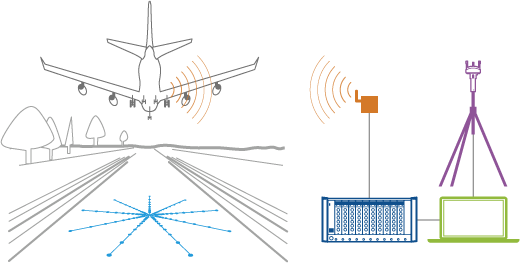
Flyover noise source identification
To map noise sources on flying aircraft, Brüel & Kjær’s flyover beamforming software traces sound to individual engine or airframe sources.
Ask an ExpertLarge arrays of microphones are laid out according to geometries designed by our specialists and connected to a network of data acquisition modules distributed to keep analogue cables short.
The aircraft position during a flyover is measured with an onboard GPS system, and synchronization with array data is achieved through recording of an IRIG-B signal together with the array data and the GPS data on the aircraft. The Beamforming calculation is performed with a standard tracking time-domain Delay and Sum (DAS) algorithm with the capability of Diagonal Removal to suppress wind noise.
For each focus point in the moving system, FFT (fast Fourier transform) and averaging in short time intervals are performed to obtain spectral noise source maps representing the aircraft positions at the middle of the intervals.
System suggestion
PULSE Array Acoustics Flyover Moving Source Beamforming BZ-5940 provides a high-resolution acoustic map of sound sources using one simple measurement of an aeroplane as it flies over a ground-based array of microphones by differentiating sound levels based on the direction from which they originate.
In addition to BZ-5940, a typical system includes a horizontal wheel array, LAN-XI data acquisition hardware and PULSE array acoustics beamforming software.

Iscriviti alla nostra Newsletter e ricevi le informazioni più recenti dal mondo del suoni e delle vibrazioni


